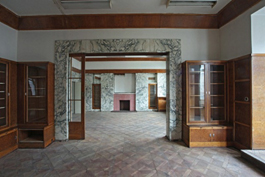
Plzeň will not return the house with the valuable interior by Loose to the state for now
 |
| source: plzen.eu |
The city hall first attempted to negotiate an extension of the deadline to 2020 with the ministry. However, the ministry wanted guarantees, such as a project that would demonstrate the intent to carry out the reconstruction, a guarantee of financing, or the inclusion of the reconstruction in the city's budget priorities. Plzeň is currently unable to provide this, and therefore the councilors, although reportedly reluctantly, proposed returning the house.
In recent years, Plzeň has renovated several of Loos's interiors, and their reconstruction has always been completed within five million crowns. The collection of interiors has become one of the major attractions and architectural treasures of the city. The costs for the house at Klatovská 19 are so high because it is not possible to only repair the extraordinarily valued interior; the entire house needs to be renovated.
It is still unclear what the next steps will be. The city wants to continue discussions with the ministry. The contract from 2005 includes a fine for the city of approximately 4.6 million crowns for non-compliance with the conditions, which is the value of the house. However, the contract is not clear, and it does not specify, for example, whether the house will return to the ministry after the penalty is paid or remain with the city.
Plzeň originally wanted to use the property for issuing identification cards, later changing the plan and intending to move the General Patton Museum there and create exhibitions about displaced Jewish families and the war history of Plzeň. However, that plan also fell through. Zrzavecký admitted that the city hall is currently struggling to find a way to utilize the property on the main busy street. The necessary funds for reconstruction have been allocated to other projects by the city in recent years. "Now it has caught up with us," he conceded.
Even though some representatives claimed that the state would not be interested in the dilapidated house, heritage conservationists fear that someone might buy it. According to municipal heritage conservationist Petr Marovič, the city has made Loos popular worldwide. Hundreds of foreign journalists have come to Plzeň because of his interiors. Therefore, they fear that if Plzeň returns the house and the state sells it, a private individual could buy it who might not make the interior accessible. The key is the remnant of Hugo Semler's apartment on the first floor. Loos realized his modifications in the early 1930s. Significantly, it is primarily the music room. According to experts, it is most likely the last of Loos's works in Plzeň; it belongs to the most significant collection of Loos's realizations in all of Europe.
The English translation is powered by AI tool. Switch to Czech to view the original text source.
0 comments
add comment
Related articles
0
12.04.2019 | In the Plzeň house with Loos interiors, there will be a new Patton Museum
0
30.11.2015 | There is interest in the apartment tours from Loose in Plzeň, with 10,000 people having seen them
0
12.11.2015 | Another Loos interior in Pilsen opened to the public
0
28.03.2015 | Repair of the unique Plzeň house by Loose took 12 years
0
25.03.2015 | Plzeň will offer regular tours of Loos' interiors
0
09.03.2015 | Loos interiors in Plzeň may be on the European Heritage List
0
06.03.2015 | Plzeň is willing to pay the contractual penalty for the house with Loose interiors
0
18.12.2014 | The house with interiors by Loose will be gradually renovated by the gallery in Plzeň
0
28.10.2014 | People in Pilsen have seen another interior by the world-renowned A. Loos for the first time
0
13.10.2014 | The route through Loos's interiors in Plzeň will offer several sites
0
23.05.2014 | Plzeň is preparing a tour route through the interiors by Adolf Loos
0
12.08.2013 | Plzeň is reconstructing the valuable Loos apartment, will offer a cultural space
0
19.03.2013 | Plzeň will open Loos's interiors for one day
0
05.04.2012 | Plzeň is preparing a reconstruction of an apartment with an interior designed by architect Loose
0
29.02.2012 | Plzeňský region will support projects of the capital city of culture
0
11.10.2011 | Exhibition in Pilsen presents the extensive work of architect Adolf Loos
0
17.04.2011 | The preservationist discovered a unique interior by Adolf Loos
0
06.04.2011 | Plzeň will make unique interiors by Loose accessible for one day
0
01.02.2011 | Prague wants to make accessible the interiors created by Adolf Loos
0
08.09.2010 | Plzeň will exceptionally make the valuable interiors of Adolf Loos accessible
0
05.09.2008 | In Pilsen, an apartment by Adolf Loos will be occasionally open to the public










